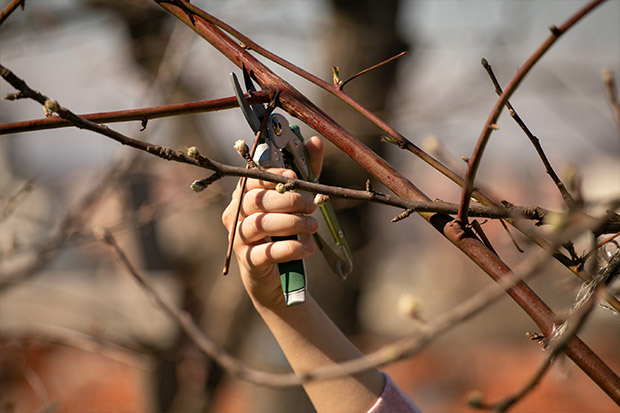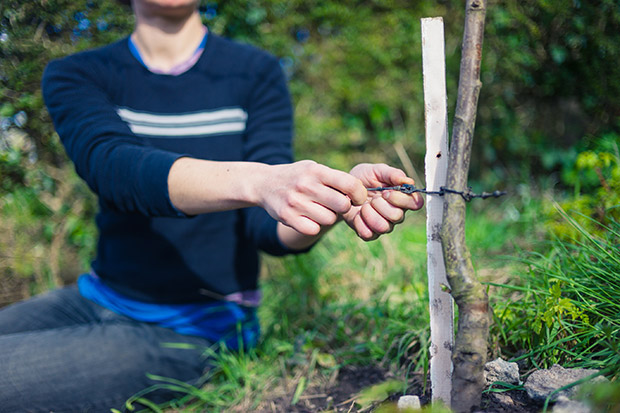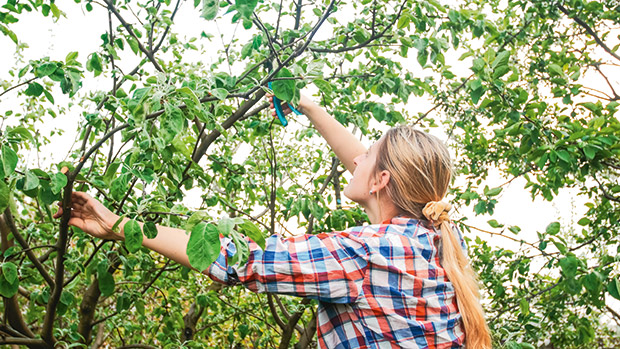How to plant and prune deciduous fruit trees

While cutting back a tree may seem counter-intuitive, pruning is an essential step to promote a fruitful harvest.
Words: Kath Irvine
PREPARE
Dig a 20-litre hole.
If the soil is clay, “puncture” the bottom of the hole by pushing a garden fork in as far as it will go.
For sandy soil, line the bottom of the hole with wet newspaper.
For heavy clay or sand, mix the original soil 50/50 with compost. With friable soil, compost is not needed.
PLANT AND BACKFILL

• Trees in planter bags need to soak in a bucket of water or dilute liquid seaweed feed before planting. Soak until bubbles no longer appear. Slit the bag open and check the roots are all heading out/ downwards. Tease out, or trim any that are not.
• Plant bare-rooted trees as soon as possible. Create a hump of soil in the hole, for upon which the roots can rest. The graft (the join of the rootstock and the tree trunk) needs to be above the soil line, and the roots must head down and out. Trim any over-long roots to fit the hole.
• Position the tree so it’s standing tall and straight.
• Backfill the hole using hands to push the soil/compost mix. The goal is to create no air gaps around the roots, which ensures a sturdy tree.
• When finished, give the tree a good tug to be sure it’s firmly in the hole.
• To stake the tree, first remove any flimsy bamboo stakes and accompanying green tape. If it is left on, the tape will grow into the bark and interrupt the precious flow of nutrients.
• For best root development to support an independent, resilient tree, the tree needs to move about a bit in the wind especially if it’s a windy area. A bit of movement stimulates root development. More roots result in a stronger tree with the ability to source a wide range of nutrients and the best shot at being drought-proof, wind-proof and heavy-crop proof.
• Drive a robust stake into the ground about 20cm away from the trunk on the windward side. Affix the tree to the stake with a soft stocking tied firmly, not rigidly.
• Remove the stake after two to three years. Trees on dwarf rootstock have shallow roots and need permanent stakes.
FEED AND WATER
• Spread a little compost on top and/or a full-spectrum mineral fertilizer plus a handful of gypsum. Don’t use sheep pellets and blood and bone. The aim is a sturdy and fruitful tree, not overly leafy.
• Water gently to further settle any air pockets around the roots, until the soil is barely moist, not soggy.
• Give a liquid feed of seaweed. Try Ocean Organics.
• Lay cardboard over the surrounding ground and spread a mixed woody mulch on top.
• Remove the plant label — a potential stranglehold if left wrapped about the trunk. Whip it off and attach it to the stake or tie.
PRUNE

1. Cut the tree at hip height or about 1m above a bud. It can feel “cruel”, but this easy, simple cut will ensure the tree is compact and full of reachable fruit. If the tree is close to this height already — leave it be.
2. Pruning inspires shoots. The first scaffold of branches and the leader (the vertical stem at the top of the trunk) will spring from this point for a low centre of gravity.
3. Well-placed feathers (branches) can be kept, or removed. The advantage of removing them is that the new ones that grow over summer will all be of the same age and have good balance.
Learn more on pruning from Kath’s book, Pruning Fruit Trees: A Beginner’s Guide, available at thisnzlife.co.nz/shop
Kath Irvine’s pruning fundamentals: When to prune and the three golden rules of pruning

